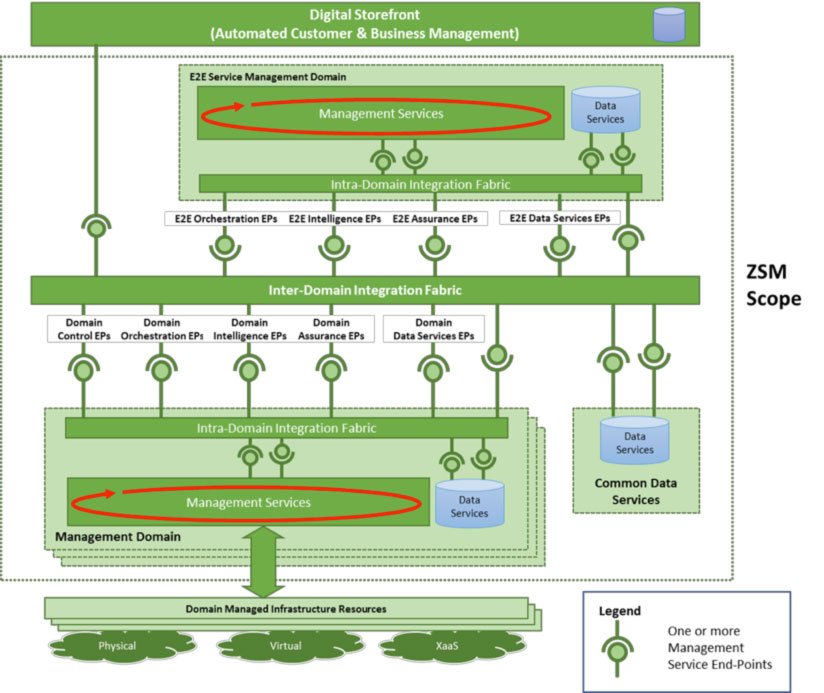ETSI ZSM Architectural Framework for End-to-End Service and Network Automation
Nurit Sprecher, ETSI ZSM
IEEE Softwarization, November 2018
The automation of network management and service delivery is becoming essential to deliver services with agility and speed, and it is needed to ensure economic sustainability of the very diverse set of services offered by Digital Service Providers.
The challenges introduced by the disruptive deployment of 5G trigger the need for network transformation and radical change in the way networks and services are managed and orchestrated. These challenges are driven by the extreme range of requirements, including seemingly infinite capacity, imperceptive latency, demand for personalized services and unmatched degree of user experience, global web-scale reach and support for massive machine-type communications. Networks are being transformed into programmable, software-driven, service-based and holistically-managed network architecture, utilizing technology enablers and catalysts, such as Network Function Virtualization (NFV), Software Defined Networking (SDN) and Multi-access Edge Computing (MEC). New business models, including those enabled by technology breakthroughs such as Network Slicing, support new markets and impose unprecedented operational agility and higher cooperation across network domains. The resulting exponential increase in overall complexity makes automation a necessity.
Service delivery must be fully automated using digital service Life Cycle Management (LCM) systems including service management, network and cloud resource management as well as a new approach to how data is managed and exposed. The ultimate automation target is to enable largely autonomous networks which are driven by high-level policies (also known as intents) and rules () defined by the service provider or a network slice tenant. Autonomous networks must be able to self-configure, self-monitor, self-heal and self-optimize without further human intervention. This requires a new architecture framework that is designed for closed-loop control and optimized for data-driven machine learning and artificial intelligence algorithms.
The ETSI Industry Specification Group (ISG) Zero touch network and Service Management (ZSM) [1] was formed in December 2017 with the goal to define a new architectural framework for end-to-end, cross-domain/cross-technology service and network that enables automation at scale and allows all operational processes and tasks – delivery, deployment, configuration, assurance, and optimization – to be executed automatically. The root design goal of ZSM is to enable zero-touch automated network and service management in a multi-vendor environment, supporting multiple way of providing automation. Network and service intelligence, as well as orchestration, are the new battlegrounds for network automation as to a large extent they are replacing human intelligence and knowledge. The ZSM architecture aims to enable new levels of agility, responsiveness and efficiency in launching new services at scale. While a first version of the architecture has been developed, the design and specification work is still in progress.
The architectural principles and requirements were agreed on with the aim of shaping the architectural baseline and guiding its further development during the standardization process. The architecture is service-based, modular, flexible and extensible. It allows deployments that can be adapted to different volumes of managed entities and/or to various scales of the geographic distribution of these entities. Modules can be independently deployed and scaled. The functional components of the architecture will also be designed for failure – so that management services can cope with failure of themselves and of the infrastructure without or only with modest service degradation.

Figure 1: ZSM Architecture
As depicted in Figure 1 above, the architecture supports the separation of management and automation into different areas of concern: (network) domain management and end-to-end (cross-domain) service management; both are responsible for fulfillment (orchestration and control), assurance and intelligent automation within their scopes.
A (network) Management Domain is the scope of management inside an operator that is typically delineated by an administrative or technological boundary (e.g. wireless domain, fixed access domain, IP/optical domain, etc.). Cloud and network resources are managed inside a network domain, including connectivity, physical and/or virtual network functions. (Network) Management Domain addresses its own sphere of expertise and abstracts the complexity of the domain resources towards management components outside the domain. Several management domains may be composed into a higher-level management domain.
End-to-end (cross-domain) Service Management Domain manages end-to-end, customer-facing services and coordinates them across domains.
Decoupling (network) Management Domain from End-to-end (cross-domain) Service Management Domain prevents monolithic systems, reduces complexity in the entire service and enables domain and end-to-end management to evolve independently. The architecture supports open interfaces as well as model-driven service and resource abstraction.
The architecture allows operational data to be kept separate from the management applications, enabling efficient access to data and cross-domain data exposure (e.g. topology, telemetry data) that can be leveraged by network and service intelligence capabilities (e.g. data-driven machine learning, artificial intelligence and other technologies for automation). The architecture is designed to enable closed-loop automation (connecting assurance and fulfillment processes) at the network and service management levels where the automated decision-making mechanisms (e.g. self-optimization, automated service assurance) can be bounded by rules and policies.
Each domain includes functional components that perform specific task(s) and expose one or more management services via service interface(s). Some of the services are internal services and can only be consumed by authorized functional components inside the domain. Other services can be exposed and also consumed by authorized functional components outside the domain (including those contained in the E2E service management domain and the digital storefront, as well as other domains). The management services within the management domain are assembled into logical groups needed for closed-loop automation, such as domain control services, domain orchestration services, domain intelligence services and domain assurance services. Other groups may be added as needed.
The management services are provided and consumed through the integration fabrics, following either the request-response / request-response-notify pattern for service invocation or the publish-subscribe pattern for live event streaming.
The ISG ZSM is currently working on the description and specification of the management services. The draft specification ETSI GS ZSM 002 "ZSM Reference Architecture" is publicly available in the ETSI ZSM Open Area [2].
For the end-to-end network and service automation solution work, existing standard specifications and solutions (both ETSI and external entities) will be analyzed and where appropriate leveraged to avoid duplication and maximize synergies. The ISG will conduct a gap analysis to ensure that existing activities are not duplicated and that the barriers to end-to-end automation are addressed. If a gap can be addressed by an existing body, that body will be encouraged to do the work to avoid duplication. The ISG will work to fill the remaining gaps.
References
[1] ETSI ZSM - https://www.etsi.org/technologies-clusters/technologies/zero-touch-network-service-management
[2] http://docbox.etsi.org/ISG/ZSM/Open
 Nurit Sprecher
Nurit Sprecher
Nurit Sprecher at Nokia serves as a vice-chair of the ETSI ISG ZSM. Before, Nurit was the founding Chair of the ETSI MEC ISG. With 25 years of experience in the telecommunication industry, she has spent many years working as a principle system architect and technologist, defining the carrier-grade network and service architecture evolution and working on system design. Nurit has contributed to many projects carried out in the IETF, ITU-T SG15, IEEE, BBF and ETSI and has participated in core discussions on the Next Generation Network with Tier-1 carriers and a number of governments.
Nurit is a contributing author to many publications. She contributed to a workshop paper for the International Conference on Communications 2016 (ICC'16), entitled "Architecture Vision for the 5G era: Cognitive and Cloud optimized Network Evolution".
Nurit leads the Nokia standardization strategy and activities in the areas of management, virtualization and application enablement and is a distinguished member of the Nokia technical committee.
Editor:
 Marie-Paule Odini
Marie-Paule Odini
Marie-Paule Odini is Distinguished Technologist in HPE focused on customer innovation and emerging trends in the communication industry including NFV, SDN, IoT, big data and 5G. She drives technical discussions towards 5G with customers and inside HPE. Active in industry forums and standard organization she held key positions such as ETSI NFV Vice Chair, IEEE SDN Chair, Editorial board member, 5G Americas key contributor and more recently co-chair of TIP (Telecom Infra Project) E2E network slicing project.
Subscribe to IEEE Softwarization
Join our free SDN Technical Community and receive IEEE Softwarization.
Article Contributions Welcomed
Download IEEE Softwarization Editorial Guidelines for Authors (PDF, 122 KB)
If you wish to have an article considered for publication, please contact the Managing Editor at sdn-editor@ieee.org.
Past Issues
IEEE Softwarization Editorial Board
Laurent Ciavaglia, Editor-in-Chief
Mohamed Faten Zhani, Managing Editor
TBD, Deputy Managing Editor
Syed Hassan Ahmed
Dr. J. Amudhavel
Francesco Benedetto
Korhan Cengiz
Noel Crespi
Neil Davies
Eliezer Dekel
Eileen Healy
Chris Hrivnak
Atta ur Rehman Khan
Marie-Paule Odini
Shashikant Patil
Kostas Pentikousis
Luca Prete
Muhammad Maaz Rehan
Mubashir Rehmani
Stefano Salsano
Elio Salvadori
Nadir Shah
Alexandros Stavdas
Jose Verger



